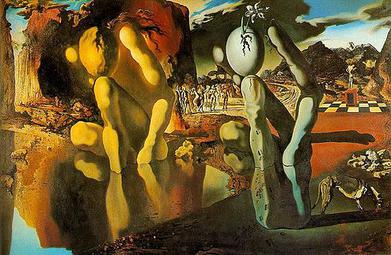
Metamorphosis of Narcissus is from Dali's paranoiac-critical period and depicts his interpretation of the Greek myth of Narcissus. Dali began his painting in the spring of 1937 while in Zurs, in the Austrian Alps. According to Greek mythology, Narcissus's beauty made him attractive to nearly everyone who saw him and both men and women pursued him, but he rejected all advances. One of his admirers, a nymph named Echo, fell so madly in love with him that, after he rejected her, she wasted away until only her voice remained.
In Dali's painting, he depicts the figure of Narcissus on the left side of the canvas crouched by a lake, with his head resting on his knee, and a stone hand clutching an egg mirroring the shape of his body on the right. From out of the cracked egg, a narcissus flower sprouts. In the mid-ground of the painting stand a group of Narcissus's rejected suitors. Among the mountains in the background rests a third Narcissus figure. Dali composed a poem that he exhibited alongside his painting in 1937, which begins:
Under the split in the retreating black cloud
the invisible scale of spring
is oscillating
in the fresh April sky.
On the highest mountain,
the god of the snow,
his dazzling head bent over the dizzy space of reflections,
starts melting with desire
in the vertical cataracts of the thaw
annihilating himself loudly among the excremental cries of minerals,
or
between [sic] the silences of mosses
towards the distant mirror of the lake
in which,
the veils of winter having disappeared,
he has newly discovered
the lightning flash
of his faithful image.
The Persistence of Memory
The Disintegration of the Persistence of Memory
Bacchanale
The Temptation of Saint Anthony
Apparition of Face and Fruit Dish on a Beach
Sleep